
In Greco-Roman mythology, Aeneas was a Trojan hero, the son of the Dardanian prince Anchises and the Greek goddess Aphrodite. His father was a first cousin of King Priam of Troy, making Aeneas a second cousin to Priam's children. He is a minor character in Greek mythology and is mentioned in Homer's Iliad. Aeneas receives full treatment in Roman mythology, most extensively in Virgil's Aeneid, where he is cast as an ancestor of Romulus and Remus. He became the first true hero of Rome. Snorri Sturluson identifies him with the Norse god Vidarr of the Æsir.
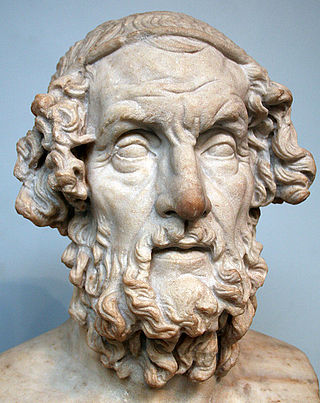
Homer was a Greek poet who is credited as the author of the Iliad and the Odyssey, two epic poems that are foundational works of ancient Greek literature. Homer is considered one of the most revered and influential authors in history.

Laocoön, is a figure in Greek and Roman mythology and the Epic Cycle. Laocoon was a Trojan priest. He and his two young sons were attacked by giant serpents, sent by the gods. The story of Laocoön has been the subject of numerous artists, both in ancient and in more contemporary times.

In Greek mythology, the Trojan War was waged against the city of Troy by the Achaeans (Greeks) after Paris of Troy took Helen from her husband Menelaus, king of Sparta. The war is one of the most important events in Greek mythology and has been narrated through many works of Greek literature, most notably Homer's Iliad. The core of the Iliad describes a period of four days and two nights in the tenth year of the decade-long siege of Troy; the Odyssey describes the journey home of Odysseus, one of the war's heroes. Other parts of the war are described in a cycle of epic poems, which have survived through fragments. Episodes from the war provided material for Greek tragedy and other works of Greek literature, and for Roman poets including Virgil and Ovid.

Publius Vergilius Maro, usually called Virgil or Vergil in English, was an ancient Roman poet of the Augustan period. He composed three of the most famous poems in Latin literature: the Eclogues, the Georgics, and the epic Aeneid. A number of minor poems, collected in the Appendix Vergiliana, were attributed to him in ancient times, but modern scholars consider his authorship of these poems as dubious.
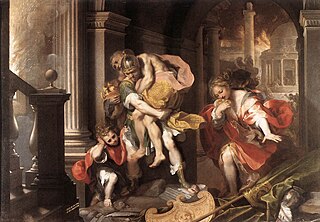
The Aeneid is a Latin epic poem, written by Virgil between 29 and 19 BC, that tells the legendary story of Aeneas, a Trojan who fled the fall of Troy and travelled to Italy, where he became the ancestor of the Romans. It comprises 9,896 lines in dactylic hexameter. The first six of the poem's twelve books tell the story of Aeneas' wanderings from Troy to Italy, and the poem's second half tells of the Trojans' ultimately victorious war upon the Latins, under whose name Aeneas and his Trojan followers are destined to be subsumed.

The tale of the founding of Rome is recounted in traditional stories handed down by the ancient Romans themselves as the earliest history of their city in terms of legend and myth. The most familiar of these myths, and perhaps the most famous of all Roman myths, is the story of Romulus and Remus, twins who were suckled by a she-wolf as infants. Another account, set earlier in time, claims that the Roman people are descended from Trojan War hero Aeneas, who escaped to Italy after the war, and whose son, Iulus, was the ancestor of the family of Julius Caesar. The archaeological evidence of human occupation of the area of modern-day Rome dates from about 14,000 years ago.
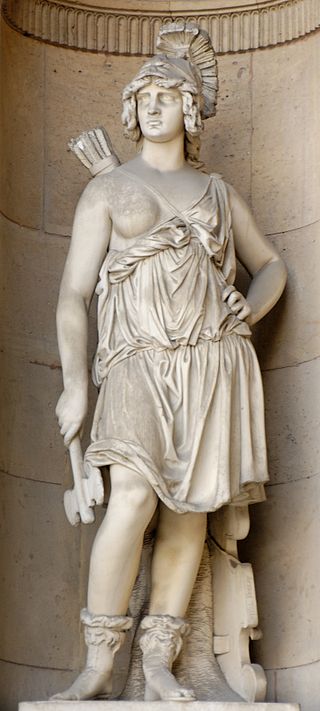
Penthesilea was an Amazonian queen in Greek mythology, the daughter of Ares and Otrera and the sister of Hippolyta, Antiope and Melanippe. She assisted Troy in the Trojan War, during which she was killed by Achilles. The asteroid 271 Penthesilea, discovered in 1887, was named in her honor.
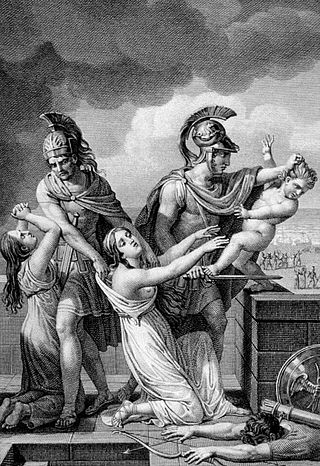
In Greek mythology, Astyanax was the son of Hector, the crown prince of Troy, and his wife, Princess Andromache of Cilician Thebe. His birth name was Scamandrius, but the people of Troy nicknamed him Astyanax, because he was the son of the city's great defender and the heir apparent's firstborn son.

In Greek mythology, Protesilaus was a hero in the Iliad who was venerated at cult sites in Thessaly and Thrace. Protesilaus was the son of Iphiclus, a "lord of many sheep"; as grandson of the eponymous Phylacos, he was the leader of the Phylaceans. Hyginus surmised that he was originally known as Iolaus—not to be confused with Iolaus, the nephew of Heracles—but was referred to as "Protesilaus" after being the first to leap ashore at Troy, and thus the first to die in the war.
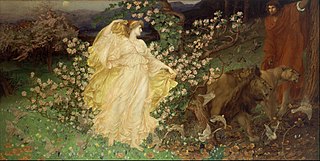
Anchises was a member of the royal family of Troy in Greek and Roman legend. He was said to have been the son of King Capys of Dardania and Themiste, daughter of Ilus, who was son of Tros. He is most famous as the father of Aeneas and for his treatment in Virgil's Aeneid. Anchises' brother was Acoetes, father of the priest Laocoön.
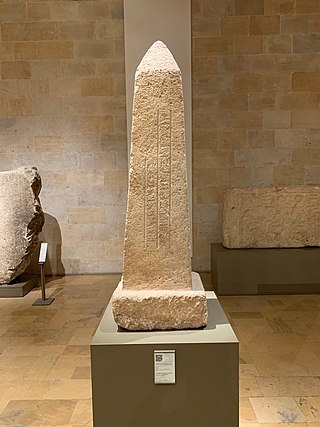
The Caucones were an autochthonous tribe of Anatolia, who later migrated to parts of the Greek mainland.
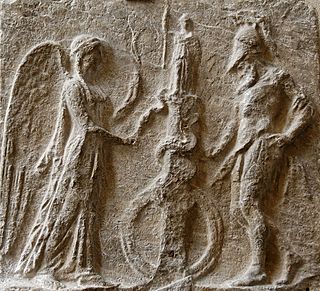
In Greek and Roman mythology, the Palladium or Palladion was a cult image of great antiquity on which the safety of Troy and later Rome was said to depend, the wooden statue (xoanon) of Pallas Athena that Odysseus and Diomedes stole from the citadel of Troy and which was later taken to the future site of Rome by Aeneas. The Roman story is related in Virgil's Aeneid and other works. Rome possessed an object regarded as the actual Palladium for several centuries; it was in the care of the Vestal Virgins for nearly all this time.
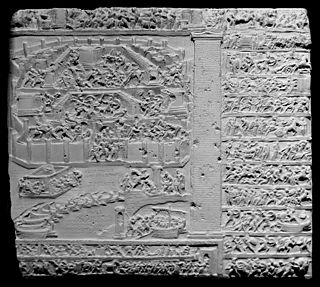
Stesichorus was a Greek lyric poet native of today's Calabria. He is best known for telling epic stories in lyric metres, and for some ancient traditions about his life, such as his opposition to the tyrant Phalaris, and the blindness he is said to have incurred and cured by composing verses first insulting and then flattering to Helen of Troy.

The extent of the historical basis of the Homeric epics, the Iliad and Odyssey, has been a topic of scholarly debate for centuries. While researchers of the 18th century had largely rejected the story of the Trojan War as fable, the discoveries made by Heinrich Schliemann at Hisarlik reopened the question in modern terms, and the subsequent excavation of Troy VIIa and the discovery of the toponym "Wilusa" in Hittite correspondence has made it plausible that the Trojan War cycle was at least remotely based on a historical conflict of the 12th century BC, even if the poems of Homer are removed from the event by more than four centuries of oral tradition.

There are a wide range of ways in which people have represented the Trojan War in literature and the arts.

The Iliad is one of two major ancient Greek epic poems attributed to Homer. It is one of the oldest extant works of literature still widely read by modern audiences. As with the Odyssey, the poem is divided into 24 books and was written in dactylic hexameter. It contains 15,693 lines in its most widely accepted version. Set towards the end of the Trojan War, a ten-year siege of the city of Troy by a coalition of Mycenaean Greek states, the poem depicts significant events in the siege's final weeks. In particular, it depicts a fierce quarrel between King Agamemnon and a celebrated warrior, Achilles. It is a central part of the Epic Cycle. The Iliad is often regarded as the first substantial piece of European literature.

The Lusus Troiae, also as Ludus Troiae and ludicrum Troiae was an equestrian event held in ancient Rome. It was among the ludi ("games"), celebrated at imperial funerals, temple foundings, or in honor of a military victory. The lusus was occasionally presented at the Saecular Games, but was not attached regularly to a particular religious festival.
Anna Sadurska (1924–2004) was a Polish Classical philologist and epigrapher who taught at the University of Warsaw.
When writing the Aeneid, Virgil drew from his studies on the Homeric epics of the Iliad to help him create a national epic poem for the Roman people. Virgil used several characteristics associated with epic poetry, more specifically Homer's epics, including the use of hexameter verse, book division, lists of genealogies and underlying themes to draw parallels between the Romans and their cultural predecessors, the Greeks.

















